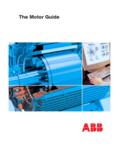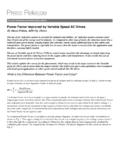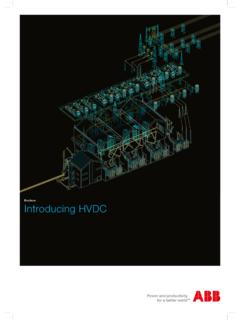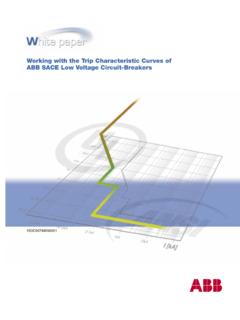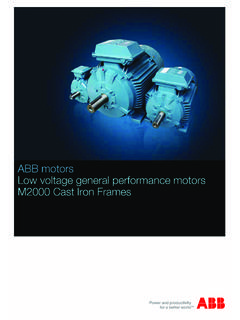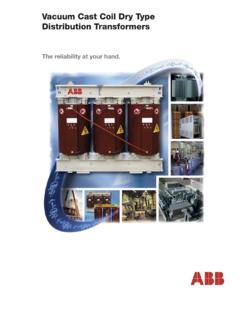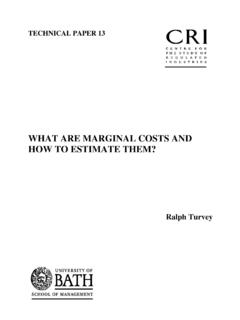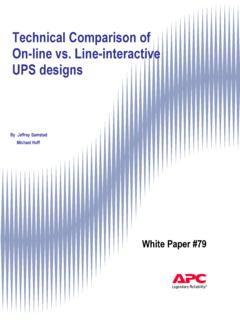Transcription of July 2008 Power factor correction and harmonic filtering ...
1 1 SDC007107G02018 July 2008 Power factor correction and harmonic filtering in electrical plants1 IndexTechnical Application PapersIntroduction .. 21 Generalities on Power factor correction .. 32 technical advantages of Power factor correction .. 4 Better utilization of electrical machines .. 5 Better utilization of electrical lines .. 5 Reduction of losses .. 6 Reduction of voltage drop .. 63 Economic advantages of Power factor correction .. 74 Production means of reac-tive Power Synchronous alternators .. 8 Synchronous compensators .. 8 Static var compensators .. 8 Banks of static capacitors.
2 95 Types of Power factor (PF) correction Distributed PF correction .. 10 Group PF 11 Centralized PF correction .. 11 Combined PF correction .. 11 Automatic PF correction .. 116 Calculation of the Power factor .. 127 Calculation of the neces-sary reactive Power .. 13 PF correction of three-phase motors .. 14 PF correction of three-phase transformers .. 178 harmonics in electrical plants harmonics .. 20 The prescriptions of the Standards .. 21 harmonic effects .. 21 Overloads ..21 Resonance ..22 harmonic filters .. 239 Switching and protection of capacitor banks Switching electrical phenomena.
3 25 Switching and protection .. 26 Choice of the protective Choice of the switching device (contactor) ..26 Choice of the capacitor ..27 Discharge of capacitors ..2810 ABB offer Circuit-breakers .. 30 Moulded-case circuit-breakers ..30 Air circuit-breakers ..32 Contactors .. 33 Contactors ..33 Contactors UA ..34 Contactors A and AF ..34 Automatic compensators .. 35 PQF filters .. 37 Annex A: Selection tables for circuit-breakers and contactors .. 42 Annex B: Reactive Power at voltage variations .. 45 Annex C: filtering and Power factor correction in distortedsteady-state.
4 46 Annex D: Voltages and currents upon switching and discharging of capacitors .. 51 Annex E: Power factor correction in photovoltaic plants .. 53 Annex F: harmonics in three-phase systems with neutral .. 54 Glossary .. 56 Power factor correction and harmonic filtering in electrical plants2 technical Application PapersPower factor correction and harmonic filtering in electrical plantsPower factor correction and harmonic filtering in electrical plants2 IntroductionIntroductionIn electrical plants the loads draw from the network elec-tric Power (active) as Power supply source ( personal computers, printers, diagnostic equipment, etc.)
5 Or con-vert it into another form of energy ( electrical lamps or stoves) or into mechanical output ( electrical motors). To get this, it is often necessary that the load exchanges with the network (with net null consumption) the reactive energy, mainly of inductive type. This energy, even if not immediately converted into other forms, contributes to increase the total Power flowing through in the electrical network, from the generators, all along the conductors, to the users. To smooth such negative effect, the Power factor correction of the electrical plants is carried Power factor correction obtained by using capacitor banks to generate locally the reactive energy necessary for the transfer of electrical useful Power , allows a better and more rational technical -economical management of the plants.
6 Moreover, the present spreading of direct current users, such as electronic circuits and electric drives, involve the generation of current harmonics which are injected into the network, with the consequent pollution and distortion of the waveforms on other connected loads. Therefore, the use of harmonic filters, both of passive as well as of active type, contributes to improve the overall Power -quality of the network, carrying out also Power factor correction at the network frequency, when such filters are properly technical paper has the purpose of analyzing these problems without going into technical details, but, start-ing from the definition of Power factor correction , from an analysis of the technical -economical advantages and describing the forms and modalities to achieve Power factor correction .
7 It wishes to guide to the convenient choice of the devices for the switching of the capacitor banks and the filtering of the harmonics . In fact, after a first descriptive part, the ABB offer is illustrated in terms of Power factor correction devices, intended not only as suitable capacitors, but also as those devices able to carry out switching and protection of the capacitor banks. Besides, some solu-tions are given for both the passive and active filtering of the current harmonics generated by distorting non-linear loads. To integrate this technical paper there are also six annexes providing: tables for the quick choice and coordination of circuit-breakers and contactors for switching and protection of capacitor banks of a determined Power ; indications on how the reactive Power generated at the variations of supply voltages changes and necessary considerations to prevent reactive Power from being injected into the network.
8 Considerations on Power factor correction and filter-ing under distorted steady-state conditions to point out how canonical Power factor correction implies a reduction of the value of the harmonics present in the network; descriptions of the voltage and current characteristics during the switching on and discharging of capacitor banks; considerations on Power factor correction in photo-voltaic plants; remarks about the contribution of harmonics to the evaluation of the current in the neutral conductor of three-phase factor correction and harmonic filtering in electrical plants P QS VIRIQI1 Generalities on Power factor correction1 Generalities on Power factor correctionIn alternating current circuits, the current absorbed by a load can be represented by two components: the active component IR, in phase with the supply voltage, is directly related to the output (and therefore to the part of electric energy converted into energy of different types.)
9 Mechanical energy, light energy, thermal ); the reactive component IQ, in quadrature to the voltage, is used to generate the flow necessary for the conver-sion of powers through the electric or magnetic field and it is index of the transfer of energy between supply and load. Without this, there could be no net transfer of Power , for example, thanks to the magnetic coupling in the core of a transformer or in the air gap of a the most common case, in the presence of ohmic-inductive type loads, the total current I lags with respect to the active component , in an electrical installation, it is necessary to generate and transmit, in addition to the active Power P, a certain reactive Power Q, which is essential for the conversion of the electrical energy but is not available to the load because exchanged with the network.
10 The complex of the Power generated and transmitted con-stitutes the apparent Power S. Power factor cos is defined as the ratio between the active component IR and the total value of the current I; is the phase angle between the voltage and the current. For a given phase voltage V, it results:cos =IR=PIST able shows the typical Power factors of some elec-trical Power factorTransformers (no load condition) working apparatuses:- Arc Arc welding Resistance melting furnace DC load1 Improving the Power factor means taking the necessary steps to increase the Power factor in a defined section of the installation by locally delivering the necessary reactive Power so that the value of the current and consequently of the Power flowing through the upstream network can be reduced, at the same required output Power .

